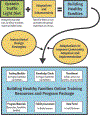Packaging of a Pediatric Weight Management Intervention and Implementation Blueprint for Rural and Micropolitan Communities: The Nebraska CORD 3.0 Project
- PMID: 34569846
- PMCID: PMC12203449
- DOI: 10.1089/chi.2021.0171
Packaging of a Pediatric Weight Management Intervention and Implementation Blueprint for Rural and Micropolitan Communities: The Nebraska CORD 3.0 Project
Abstract
Pediatric weight management interventions (PWMIs) have resulted in positive changes among family members and, if widely disseminated, could have an impact on pediatric weight management in rural communities. The purpose of this article is to describe a backward design approach taken to create an online packaged program and implementation blueprint for building healthy families (BHF), an effective PWMI for implementation in rural communities. The backward design process included the identification of end users: primary (facilitators to be trained through the packaged program and implementation blueprint), secondary (researchers and evaluators), terminal (caregivers and children impacted by PWMI participation), tertiary (community support organizations, funding agency promoting widespread PWMI, and payors), as well as, key outcomes for respective end user groups based on the reach, effectiveness, adoption, implementation, and maintenance (RE-AIM) framework. This process resulted in the BHF Online Training Resources and Program package and implementation blueprint that included a modular approach encompassing the interplay of training modules for program facilitators, knowledge checks to ensure mastery of program components, recruitment resources for school and clinical settings, all program materials, embedded fidelity assessments for quality assurance, and a data portal to track participant success. Next steps include preliminary product testing with potential facilitators and a type 3 effectiveness implementation trial to determine the utility of the BHF Online Training Resources and Program package with and without participation in a learning collaborative to support implementation and sustainability.
Keywords: implementation science; obesity; packaged program; pediatric.
Conflict of interest statement
Author Disclosure Statement
No competing financial interests exist.
Figures
Similar articles
-
Using a customer discovery process to enhance the potential dissemination and scalability of a family healthy weight program for rural communities and small towns.Int J Behav Nutr Phys Act. 2024 May 14;21(1):57. doi: 10.1186/s12966-024-01605-7. Int J Behav Nutr Phys Act. 2024. PMID: 38745324 Free PMC article.
-
A Type III Hybrid Effectiveness-Implementation Pilot Trial Testing Dissemination and Implementation Strategies for a Pediatric Weight Management Intervention: The Nebraska Childhood Obesity Research Demonstration Project.Child Obes. 2021 Sep;17(S1):S70-S78. doi: 10.1089/chi.2021.0170. Child Obes. 2021. PMID: 34569848 Free PMC article.
-
Health professionals' experience of teamwork education in acute hospital settings: a systematic review of qualitative literature.JBI Database System Rev Implement Rep. 2016 Apr;14(4):96-137. doi: 10.11124/JBISRIR-2016-1843. JBI Database System Rev Implement Rep. 2016. PMID: 27532314
-
Strategies for enhancing the implementation of school-based policies or practices targeting risk factors for chronic disease.Cochrane Database Syst Rev. 2017 Nov 29;11(11):CD011677. doi: 10.1002/14651858.CD011677.pub2. Cochrane Database Syst Rev. 2017. Update in: Cochrane Database Syst Rev. 2022 Aug 29;8:CD011677. doi: 10.1002/14651858.CD011677.pub3. PMID: 29185627 Free PMC article. Updated.
-
Adaptations of an Effective Evidence-Based Pediatric Weight Management Intervention.Prev Sci. 2024 Apr;25(Suppl 1):72-84. doi: 10.1007/s11121-023-01557-7. Epub 2023 Jul 21. Prev Sci. 2024. PMID: 37477808 Free PMC article.
Cited by
-
Using a customer discovery process to enhance the potential dissemination and scalability of a family healthy weight program for rural communities and small towns.Int J Behav Nutr Phys Act. 2024 May 14;21(1):57. doi: 10.1186/s12966-024-01605-7. Int J Behav Nutr Phys Act. 2024. PMID: 38745324 Free PMC article.
-
Coming together for something good: recommendations from a scoping review for dissemination and implementation science to improve indigenous substance use disorder treatment.Front Public Health. 2023 Oct 17;11:1265122. doi: 10.3389/fpubh.2023.1265122. eCollection 2023. Front Public Health. 2023. PMID: 37915816 Free PMC article.
-
Scoping review of costs of implementation strategies in community, public health and healthcare settings.BMJ Open. 2022 Jun 28;12(6):e060785. doi: 10.1136/bmjopen-2022-060785. BMJ Open. 2022. PMID: 35768106 Free PMC article.
-
A Type III Hybrid Effectiveness-Implementation Pilot Trial Testing Dissemination and Implementation Strategies for a Pediatric Weight Management Intervention: The Nebraska Childhood Obesity Research Demonstration Project.Child Obes. 2021 Sep;17(S1):S70-S78. doi: 10.1089/chi.2021.0170. Child Obes. 2021. PMID: 34569848 Free PMC article.
-
Understanding implementation costs of a pediatric weight management intervention: an economic evaluation protocol.Implement Sci Commun. 2022 Apr 5;3(1):37. doi: 10.1186/s43058-022-00287-1. Implement Sci Commun. 2022. PMID: 35382891 Free PMC article.
References
-
- Epstein LH, McCurley J, Wing RR, Valoski A. Five-year follow-up of family-based behavioral treatments for childhood obesity. J Consult Clin Psychol 1990;58:661–664. - PubMed
-
- Epstein LH, Wing R, Penner BC, et al. Effects of family-based behavioral treatment on obese 5-to-8 year-old children. Behav Ther 1985;16:205–212.
-
- Epstein LH, Wing RR, Koeske R, et al. Child and parent weight loss in family-based behavior modification programs. J Consult Clin Psychol 1981;49:674–685. - PubMed
-
- Epstein LH, Wing RR, Koeske R, Valoski A. Long-term effects of family-based treatment of childhood obesity. J Consult Clin Psychol 1987;55:91–95. - PubMed
-
- Savoye M, Shaw M, Dziura J, et al. Effects of a weight management program on body composition and metabolic parameters in overweight children: A randomized controlled trial. JAMA 2007;297:2697–2704. - PubMed
Publication types
MeSH terms
Grants and funding
LinkOut - more resources
Full Text Sources
Medical





